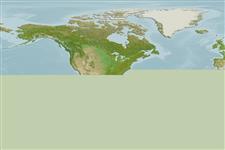Environment: milieu / climate zone / depth range / distribution range
Ecologia
marino; salmastro; distribuzione batimetrica ? - 35 m (Ref. 26912). Tropical; 23°N - 27°S, 85°W - 32°W (Ref. 189)
Western Atlantic: Antilles, Trinidad south to Brazil; also Venezuela to Panama and Honduras but not Gulf of Mexico. Meristic data tends to support three geographic units: South America (east Colombia, Venezuela south to Brazil); Antillean (and some islands off Venezuela); West Caribbean (Gulf of Honduras).
Size / Peso / Age
Maturity: Lm ? range ? - ? cm
Max length : 14.5 cm TL maschio/sesso non determinato; (Ref. 124483); common length : 10.0 cm TL maschio/sesso non determinato; (Ref. 5217); peso massimo pubblicato: 21.29 g (Ref. 124483)
Spine dorsali (totale) : 0; Spine anali: 0; Raggi anali molli: 17 - 21. Snout long and pointed, only slightly less than eye diameter; maxilla long, tip pointed, reaching almost to gill opening, teeth near tip somewhat enlarged; gill cover canals of panamensis-type; pseudobranch longer than eye diameter, with 30 or more filaments, extending onto inner face of operculum. First pectoral fin ray filamentous. Silver stripe along flank about eye diameter.
A schooling species occurring in coastal waters. Trawled down to 25 m off Brazil, but equally taken in shore seines and recorded in salinities of 7.94-8.21 ppt in the Canal de Santa Cruz, Pernambuco, Brazil (Ref. 189).
Life cycle and mating behavior
Maturità | Riproduzione | Deposizione | Uova | Fecundity | Larve
Spawn in school (Ref. 205).
Whitehead, P.J.P., G.J. Nelson and T. Wongratana, 1988. FAO Species Catalogue. Vol. 7. Clupeoid fishes of the world (Suborder Clupeoidei). An annotated and illustrated catalogue of the herrings, sardines, pilchards, sprats, shads, anchovies and wolf-herrings. FAO Fish. Synop. 125(7/2):305-579. Rome: FAO. (Ref. 189)
IUCN Red List Status (Ref. 130435: Version 2024-1)
Threat to humans
Harmless
Human uses
Pesca: scarso interesse commerciale
Strumenti
Special reports
Download XML
Fonti Internet
Estimates based on models
Preferred temperature (Ref.
123201): 27 - 28.2, mean 27.6 °C (based on 421 cells).
Phylogenetic diversity index (Ref.
82804): PD
50 = 0.5000 [Uniqueness, from 0.5 = low to 2.0 = high].
Bayesian length-weight: a=0.00447 (0.00271 - 0.00737), b=3.20 (3.06 - 3.34), in cm total length, based on LWR estimates for this species & Genus-body shape (Ref.
93245).
Trophic level (Ref.
69278): 3.4 ±0.4 se; based on size and trophs of closest relatives
Resilienza (Ref.
120179): Medio, tempo minimo di raddoppiamento della popolazione 1.4 - 4.4 anni (Fec=1,644 (batch fecundity)).
Fishing Vulnerability (Ref.
59153): Low vulnerability (10 of 100).
